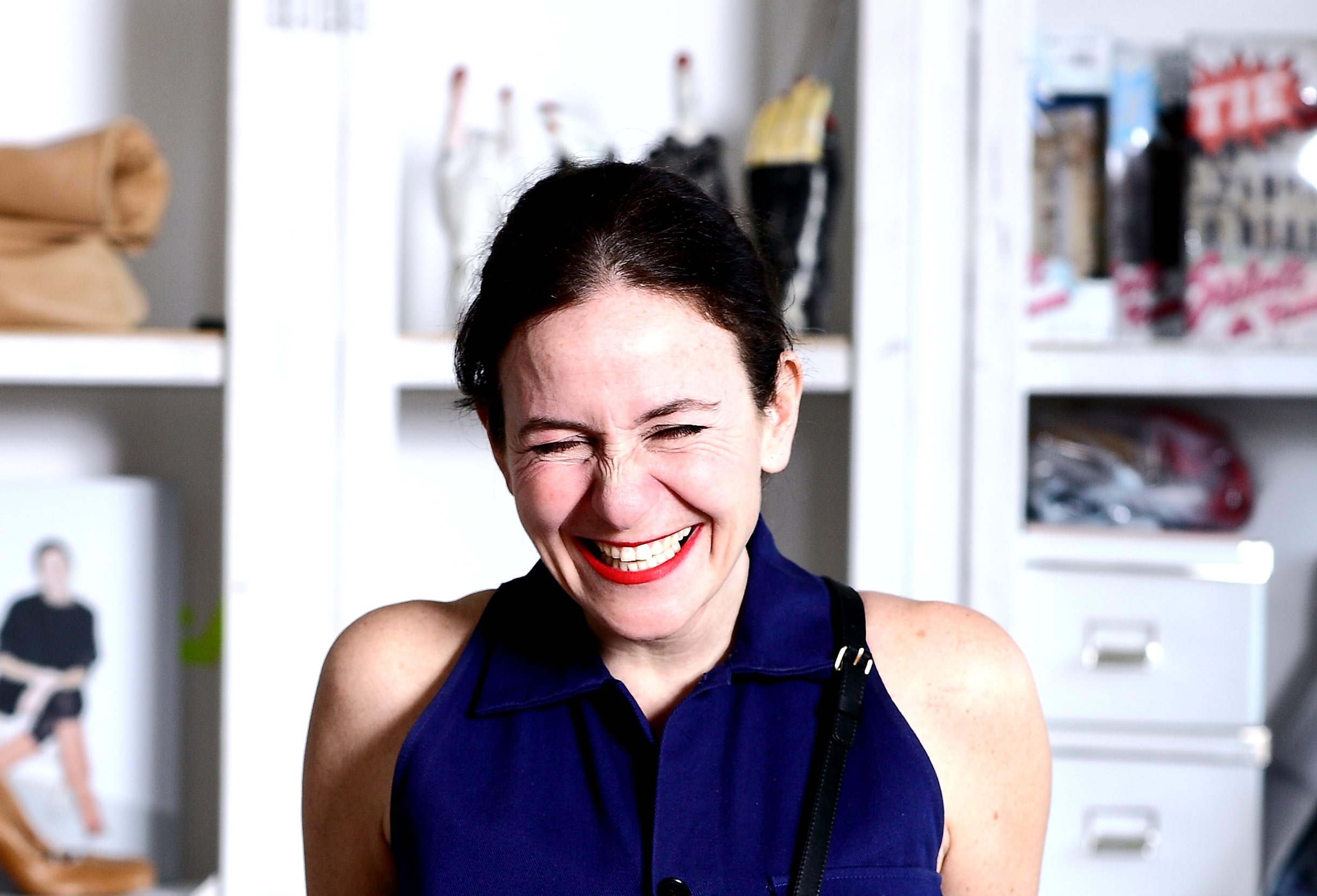
La mise en abyme di Gentucca Bini
“La moda è l’unica disciplina che mi ha permesso di unire tutto. Dalla fotografia allo stile, dalla rappresentazione alla progettazione. È un microcosmo. Il mio”

La mise en abyme in letteratura indica un particolare tipo di “storia nella storia”, in cui la trama raccontata può essere usata per riassumere o racchiudere alcuni aspetti dell’intreccio narrativo che la incornicia. Immaginate allora una casa in corso Matteotti a Milano negli anni ’60. Popolatela di una stilista intellettuale tanto audace da realizzare vestiti con artisti del calibro di Fontana e Duchamp. Aggiungete un primo ballerino della Scala, un sarto napoletano, una gallerista d’arte e tre fratelli architetti che grazie ai loro gioielli diventano direttori creativi di Pierre Cardin. Lasciate crescere una bambina in questo vortice di creatività. Avrete allora Gentucca Bini, architetto di formazione ma progettista di moda di professione.
I personaggi, in questa storia, sono il centro motore. Come inizia?
Io sono nata e cresciuta in una famiglia di creativi, culturalmente elevata. Mia nonna aveva un atelier di alta moda in via Monte Napoleone a Milano e nel ’61 è stata la prima stilista, grande intellettuale, a fare vestiti con i suoi amici artisti che di lì a poco avrebbero dettato tutte le regole dell’arte contemporanea. Parliamo di Pomodoro, Fontana, Max Ernst e Duchamp ad esempio. Mio nonno era invece il primo ballerino alla Scala, poi diventato un attore. In questo contesto sono cresciuti tre bambini, mio padre Stefano e i suoi due fratelli, che si sono formati come architetti per poi essere i ‘tre moschettieri’ di Pierre Cardin. È entrata a fare parte della famiglia anche mia madre che aveva una galleria d’arte contemporanea.

Insomma … ARTE, ARTE, ARTE! Parlavi di tuo padre e dei suoi fratelli come i ‘tre moschettieri’ di Pierre Cardin. Tutto è iniziato con l’acquisto di un macchinario per realizzare gioielli, com’è continuata la storia?
Mio padre Stefano e i suoi due fratelli a 20 anni decidono di acquistare un macchinario in via della Spiga, da un artigiano da cui mia nonna faceva realizzare i gioielli per sé. Di conseguenza iniziano a comprare oro e argento e a sperimentare nella creazione di monili meccanici, grandi e bellissimi. Mia nonna, vedendo i risultati, gli suggerisce di mostrarli ad un suo grande amico: Nino Cerruti. Così fanno, riempiendo una valigia di gioielli inaspettati per l’epoca. Così inaspettati e geniali che Nino Cerruti, guardandoli, realizza quanto fossero troppo all’avanguardia per il suo stile ancora legato ad un gusto classico. Chiama quindi Pierre Cardin, capendo immediatamente che sarebbe potuto essere artefice di un incontro felice. Così fu. Pierre Cardin si innamora dei gioielli di mio padre al punto che non fa delle commissioni, ma crea un vero e proprio lavoro di collaborazione, motivo per cui mio papà e i suoi fratelli erano chiamati all’epoca i ‘tre moschettieri’ di Pierre Cardin. Per lui hanno fatto tutto, dai negozi ai gioielli, alle sfilate. Si sono inventati un mondo insieme e con i fratelli Bini, Cardin è diventato spaziale.
Guardandole oggi, cosa pensi delle loro creazioni?
Facevano delle cose straordinarie per l’epoca. Gioielli meccanici che non erano mai stati fatti e che anche oggi appaiono assolutamente attuali nella loro elaborazione. È affascinante come un gioiello possa avere un’importanza tale che supera l’aspetto estetico e rientra nella sfera progettuale al punto da essere esteso ad una scala diversa. È straordinario infatti il legame che c’è tra l’architettura e il gioiello. I negozi di Cardin, quello di Milano e di Parigi, sono stati fatti da mio padre e i suoi fratelli e c’è una sintonia sorprendente tra il prodotto e il retail. Pierre Cardin mi dice sempre ‘Tuo padre e i tuoi zii erano dei geni e io mi maledico per aver distrutto i loro negozi che erano espressione della loro creatività’. I negozi che loro avevano progettato non esistono più e in archivio abbiamo pochissimi dei loro gioielli ma per fortuna abbiamo conservato tutta la stampa di quel periodo, che è prova della grandezza delle loro creazioni.
In questo contesto come è stato decidere cosa fare da grande?
È stato difficile. In un contesto così vale tutto e impari ad essere indipendente, libero, ad utilizzare i sistemi ma non aderire completamente ad essi. Quando ho dovuto scegliere che strada prendere ho pensato che l’architettura mi consentisse di coltivare tutti i miei interessi e al tempo stesso mi desse un’impronta e dei limiti progettuali. Così per un esame di scenografia ho prodotto, come primo progetto architettonico, un cappello. Oltre ad un ottimo risultato all’università, mio papà mi ha suggerito di esporlo e renderlo visibile a tutti.

Ricorda l’incoraggiamento di tua nonna a tuo padre e i suoi fratelli. Anche tu hai seguito il consiglio?
Certo, e nel ’91 ho fatto la mia prima mostra di cappelli e accessori assurdi utilizzando materiali sbagliati e decontestualizzati in modo semplice, quasi infantile. Così assurdi e rari che hanno colpito i personaggi che avevo invitato all’opening e sono stati pubblicati sulla stampa. Da lì ho iniziato il mio percorso nella moda come assistente di André Leon Talley, direttore creativo di Vogue America. Grazie a questo lavoro Karl Lagerfeld ha visto i miei cappelli e li ha usati per le sfilate e così hanno fatto Blumarine, Ferré’ e tutti i più grandi stilisti. Questo ha sancito il mio legame con la moda e nel tempo i miei accessori sono diventati più vestibili, vendibili e si sono trasformati in vestiti. Nel 2003 ho fatto la mia prima sfilata e ho deciso di investire su me stessa. Da allora ho fatto tantissimi progetti speciali, dalle uniformi alle collaborazioni con Alcantara, dai progetti per gli eventi di Aliita fino al mio ultimo progetto della Pussy Bag per dare un messaggio forte sulla violenza sulle donne, per citarne solo alcuni. La moda è l’unica disciplina che mi ha permesso di unire tutto. Dalla fotografia allo stile, dalla rappresentazione alla progettazione. È un microcosmo. Il mio.
Per le tue creazioni attingi mai all’archivio che la tua famiglia ha lasciato?
Non ce n’è bisogno. Sono cresciuta con questi esempi in casa. Da piccola sentivo le conversazioni, vivevo gli spazi e mi è rimasto tutto. I vestiti di mia nonna ad esempio, fatti a quattro mani con gli artisti, li ricordo perfettamente. Tanto che il primo vestito che io ho realizzato è stato una riproduzione sottovuoto dei vestiti creati da mia nonna. Stessi colori, stessa forma, ma senza firma e venduti come dei poster.
Non hai mai pensato di guardare invece ai progetti di tuo padre per realizzare gioielli?
Il gioiello ha una fase di lavorazione che mi sfugge. A 16 anni mi hanno mandata in fonderia per sperimentare con il bronzo. Io so fare la cera persa, sono capace di fondere il metallo ma, per me, c’è un gap tra la mia mente e la mia mano. Però a me piacciono le sfide e il gioiello mi interessa quindi magari, chissà, il prossimo passo potrebbe essere questo.

A background in fashion, jewellery and art: the mise en abyme of Gentucca Bini
Gentucca Bini was a child of the 1960s, growing up in a house in Corso Matteotti, Milan, surrounded by creative talent: a bold, intelligent stylist who made clothes with Fontana and Duchamp, a leading dancer with La Scala, a Neapolitan tailor, an art gallery owner, and three brother architects and jewellery-designers who became creative directors for Pierre Cardin. Following such a childhood, Bini trained as an architect, before adopting fashion design as her profession.
The characters in this story are the driving force behind her work. How did it all start?
I grew up in a creative family. My grandmother ran an haute couture studio in Via Monte Napoleone. In 1961, she became the first stylist to work with artists to design clothes: friends such as Pomodoro, Fontana, Max Ernst and Duchamp. My grandfather was the leading dancer at La Scala, and then became an actor. My father and his two brothers grew up in this setting, and they all trained as architects, later becoming Pierre Cardin’s ‘three musketeers’. My mother had a modern art gallery.
Well, there you have it… ART!
You mentioned your father and his brothers were Pierre Cardin’s ‘Three Musketeers’. It all started when they bought a machine for making jewellery, but how did the story continue?
My father and his brothers acquired this machine from a craftsman who made jewellery for my grandmother. Then they bought some gold and silver and started making large mechanical necklaces. My grandmother suggested they show them to her friend Nino Cerruti, but he thought them too avant-garde for his particular style and called Pierre Cardin, who agreed to work with them. This is why my father and his brothers were called Pierre Cardin’s ‘three musketeers’. They helped him design shops, jewellery, and even fashion shows. They invented a whole world together, and Cardin achieved amazing success with the Bini brothers.
If you look at their designs now, what do you think of them?
They were extraordinary for their time. Mechanical jewellery is still around today. It’s fascinating how a piece of jewellery can become more than just an attractive object and influence design in other spheres.
The Cardin stores in Milan and Paris were designed by my father and his brothers, and there was surprising harmony between the product and the retail space. Those shops no longer exist, and we have kept just a few pieces of their jewellery; but we have all the moulds from that period, which prove the greatness of their creations.
In this setting, how did you decide what to do when you grew up?
That was hard. When it came to making a choice, I thought that architecture would allow me to follow my interests, and provide a certain shape and framework for my designs. So, for an exam in stage set design, I made a hat, and that was my first architecture project. The university gave me top marks, and my father suggested I display the hat so others could see it.
You obviously remember the way your grandmother encouraged your father and his brothers. So, did you follow his advice?
I put on my first show of hats and accessories in 1991, and they were so absurd that they were written about in the press. I began my career in fashion as an assistant to André Leon Talley, creative director of Vogue America. Karl Lagerfeld saw my hats and used them for fashion shows, and so did Blumarine, Ferré and other major designers. My accessories became more wearable and saleable, and developed into clothes. In 2003, I had my first fashion show. Fashion allowed me to combine everything. From photography to style, and from representation to design. It’s a microcosm. My microcosm.
Do you ever draw on your family archive for your creations?
I don’t need to. It’s all still there. The first dress I produced was a faithful replica of the dresses my grandmother made. Same colours, same shape, but without a signature and sold as a poster.
Have you ever considered looking at your father’s designs for making jewellery?
Jewellery-making is a craft that has passed me by. When I was 16, I tried working with bronze in the foundry; I know the lost wax process and how to cast metal, but my mind and hand just don’t coordinate. I like challenges, and jewellery interests me; who knows, that might be my next phase.

POST COMMENT